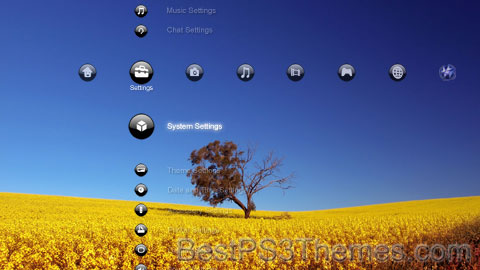Earth theme by tony
Download: Earth_4.p3t
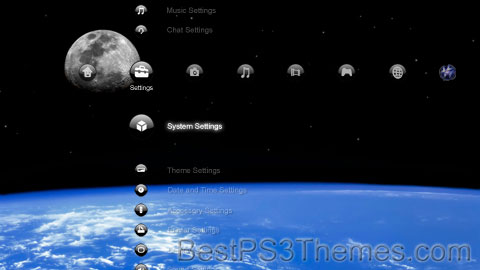
(3 backgrounds)
 The Blue Marble, Apollo 17, December 1972 | |||||||||||||||||||||||||||||||||||||||||||||||||||||||||||||||||||||||||||||||||||||||||||||||||||||||||||||||||||||||||||||||||||||
| Designations | |||||||||||||||||||||||||||||||||||||||||||||||||||||||||||||||||||||||||||||||||||||||||||||||||||||||||||||||||||||||||||||||||||||
|---|---|---|---|---|---|---|---|---|---|---|---|---|---|---|---|---|---|---|---|---|---|---|---|---|---|---|---|---|---|---|---|---|---|---|---|---|---|---|---|---|---|---|---|---|---|---|---|---|---|---|---|---|---|---|---|---|---|---|---|---|---|---|---|---|---|---|---|---|---|---|---|---|---|---|---|---|---|---|---|---|---|---|---|---|---|---|---|---|---|---|---|---|---|---|---|---|---|---|---|---|---|---|---|---|---|---|---|---|---|---|---|---|---|---|---|---|---|---|---|---|---|---|---|---|---|---|---|---|---|---|---|---|---|
| The world, the globe, Sol III, Terra, Tellus, Gaia, Mother Earth | |||||||||||||||||||||||||||||||||||||||||||||||||||||||||||||||||||||||||||||||||||||||||||||||||||||||||||||||||||||||||||||||||||||
| Adjectives | Earthly, terrestrial, terran, tellurian | ||||||||||||||||||||||||||||||||||||||||||||||||||||||||||||||||||||||||||||||||||||||||||||||||||||||||||||||||||||||||||||||||||||
| Symbol |
Fields #2Fields theme by tony Download: Fields_2.p3t
Look up fields in Wiktionary, the free dictionary. Fields may refer to: Music[edit]
Businesses[edit]
Places in the United States[edit]
Other uses[edit]
See also[edit]
MacOs v1.1MacOs v1.1 theme by Pixelhunter Download: MacOsv1.1.p3t
P3T Unpacker v0.12 This program unpacks Playstation 3 Theme files (.p3t) so that you can touch-up an existing theme to your likings or use a certain wallpaper from it (as many themes have multiple). But remember, if you use content from another theme and release it, be sure to give credit! Download for Windows: p3textractor.zip Instructions: Download p3textractor.zip from above. Extract the files to a folder with a program such as WinZip or WinRAR. Now there are multiple ways to extract the theme. The first way is to simply open the p3t file with p3textractor.exe. If you don’t know how to do this, right click the p3t file and select Open With. Alternatively, open the p3t file and it will ask you to select a program to open with. Click Browse and find p3textractor.exe from where you previously extracted it to. It will open CMD and extract the theme to extracted.[filename]. After that, all you need to do for any future p3t files is open them and it will extract. The second way is very simple. Just drag the p3t file to p3textractor.exe. It will open CMD and extract the theme to extracted.[filename]. For the third way, first put the p3t file you want to extract into the same folder as p3textractor.exe. Open CMD and browse to the folder with p3extractor.exe. Enter the following: Nature’s Finest HDNature’s Finest HD theme by Droopysp Download: NaturesFinestHD.p3t
P3T Unpacker v0.12 This program unpacks Playstation 3 Theme files (.p3t) so that you can touch-up an existing theme to your likings or use a certain wallpaper from it (as many themes have multiple). But remember, if you use content from another theme and release it, be sure to give credit! Download for Windows: p3textractor.zip Instructions: Download p3textractor.zip from above. Extract the files to a folder with a program such as WinZip or WinRAR. Now there are multiple ways to extract the theme. The first way is to simply open the p3t file with p3textractor.exe. If you don’t know how to do this, right click the p3t file and select Open With. Alternatively, open the p3t file and it will ask you to select a program to open with. Click Browse and find p3textractor.exe from where you previously extracted it to. It will open CMD and extract the theme to extracted.[filename]. After that, all you need to do for any future p3t files is open them and it will extract. The second way is very simple. Just drag the p3t file to p3textractor.exe. It will open CMD and extract the theme to extracted.[filename]. For the third way, first put the p3t file you want to extract into the same folder as p3textractor.exe. Open CMD and browse to the folder with p3extractor.exe. Enter the following: Mac OS #2Mac OS theme by Pixelhunter Download: MacOS_2.p3t
Redirect to:
WaterWater theme by HotPixelUS Download: Water.p3t
Water is an inorganic compound with the chemical formula H2O. It is a transparent, tasteless, odorless,[c] and nearly colorless chemical substance, and it is the main constituent of Earth's hydrosphere and the fluids of all known living organisms (in which it acts as a solvent[19]). It is vital for all known forms of life, despite not providing food energy or organic micronutrients. Its chemical formula, H2O, indicates that each of its molecules contains one oxygen and two hydrogen atoms, connected by covalent bonds. The hydrogen atoms are attached to the oxygen atom at an angle of 104.45°.[20] In liquid form, H2O is also called "water" at standard temperature and pressure. Because Earth's environment is relatively close to water's triple point, water exists on Earth as a solid, a liquid, and a gas.[21] It forms precipitation in the form of rain and aerosols in the form of fog. Clouds consist of suspended droplets of water and ice, its solid state. When finely divided, crystalline ice may precipitate in the form of snow. The gaseous state of water is steam or water vapor. Water covers about 71% of the Earth's surface, with seas and oceans making up most of the water volume (about 96.5%).[22] Small portions of water occur as groundwater (1.7%), in the glaciers and the ice caps of Antarctica and Greenland (1.7%), and in the air as vapor, clouds (consisting of ice and liquid water suspended in air), and precipitation (0.001%).[23][24] Water moves continually through the water cycle of evaporation, transpiration (evapotranspiration), condensation, precipitation, and runoff, usually reaching the sea. Water plays an important role in the world economy. Approximately 70% of the fresh water used by humans goes to agriculture.[25] Fishing in salt and fresh water bodies has been, and continues to be, a major source of food for many parts of the world, providing 6.5% of global protein.[26] Much of the long-distance trade of commodities (such as oil, natural gas, and manufactured products) is transported by boats through seas, rivers, lakes, and canals. Large quantities of water, ice, and steam are used for cooling and heating in industry and homes. Water is an excellent solvent for a wide variety of substances, both mineral and organic; as such, it is widely used in industrial processes and in cooking and washing. Water, ice, and snow are also central to many sports and other forms of entertainment, such as swimming, pleasure boating, boat racing, surfing, sport fishing, diving, ice skating, snowboarding, and skiing. Etymology[edit]The word water comes from Old English wæter, from Proto-Germanic *watar (source also of Old Saxon watar, Old Frisian wetir, Dutch water, Old High German wazzar, German Wasser, vatn, Gothic HighwayHighway theme by CGJ Download: Highway.p3t
  A highway is any public or private road or other public way on land. It includes not just major roads, but also other public roads and rights of way. In the United States, it is also used as an equivalent term to controlled-access highway, or a translation for motorway, Autobahn, autostrada, autoroute, etc.[1] According to Merriam-Webster, the use of the term predates the 12th century. According to Etymonline, "high" is in the sense of "main". In North American and Australian English, major roads such as controlled-access highways or arterial roads are often state highways (Canada: provincial highways). Other roads may be designated "county highways" in the US and Ontario. These classifications refer to the level of government (state, provincial, county) that maintains the roadway. In British English, "highway" is primarily a legal term. Everyday use normally implies roads, while the legal use covers any route or path with a public right of access, including footpaths etc. The term has led to several related derived terms, including highway system, highway code, highway patrol and highwayman. Overview[edit]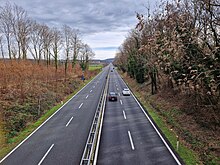 Major highways are often named and numbered by the governments that typically develop and maintain them. Australia's Highway 1 is the longest national highway in the world at over 14,500 kilometres (9,000 mi) and runs almost the entire way around the continent. China has the world's largest network of highways, followed closely by the United States. Some highways, like the Pan-American Highway or the European routes, span multiple countries. Some major highway routes include ferry services, such as US Route 10, which crosses Lake Michigan. Traditionally highways were used by people on foot or on horses. Later they also accommodated carriages, bicycles and eventually motor cars, facilitated by advancements in road construction. In the 1920s and 1930s, many nations began investing heavily in highway systems in an effort to spur commerce and bolster national defence. Major highways that connect cities in populous developed and developing countries usually incorporate features intended to enhance the road's capacity, efficiency, and safety to various degrees. Such features include a reduction in the number of locations for user access, the use of dual carriageways with two or more lanes on each carriageway, and grade-separated junctions with other roads and modes of transport. These features are typically present on highways built as motorways (freeways). Terminology[edit]England and Wales[edit]The general legal definition deals with right of use, not the form of construction; this is distinct from e.g. the popular use of the word in the US. A highway is defined in English common law by a number of similarly worded definitions such as "a way over which all members of the public have the right to pass and repass without hindrance"[2] usually accompanied by "at all times"; ownership of the ground is for most purposes irrelevant, thus the term encompasses all such ways from the widest trunk roads in public ownership to the narrowest footpath providing unlimited pedestrian access over private land. A highway might be open to all forms of lawful land traffic (e.g. vehicular, horse, pedestrian) or limited to specific modes of traffic; usually a highway available to vehicles is also available to foot or horse traffic, a highway available to horse traffic is available to cyclists and pedestrians; but there are exceptional cases in which a highway is only available to vehicles, or is subdivided into dedicated parallel sections for different users. A highway can share ground with a private right of way for which full use is not available to the general public: for example farm roads which the owner may use for any purpose but for which the general public only has a right of use on foot or horseback. The status of highway on most older roads has been gained by established public use, while newer roads are typically dedicated as highways from the time they are adopted (taken into the care and control of a council or other public authority). In England and Wales, a public highway is also known as "The King's Highway".[3] The core definition of a highway is modified in various legislation for a number of purposes but only for the specific matters dealt with in each such piece of legislation. This is typically in the case of bridges, tunnels and other structures whose ownership, mode of use or availability would otherwise exclude them from the general definition of a highway. Recent examples include toll bridges and tunnels which have the definition of highway imposed upon them (in a legal order applying only to the individual structure) to allow application of most traffic laws to those using them but without causing all of the general obligations or rights of use otherwise applicable to a highway. Limited access highways for vehicles, with their own traffic rules, are called "motorways" in the UK.[4] Scotland[edit]Scots law is similar to English law with regard to highways but with differing terminology and legislation. What is defined in England as a highway will often in Scotland be what is defined by s.151 Roads (Scotland) Act 1984 (but only "in this act" although other legislation could imitate) simply as a road, that is:
The word highway is itself no longer a statutory expression in Scots law[5] but remains in common law. United States[edit] In American law, the word "highway" is sometimes used to denote any public way used for travel, whether a "road, street, and parkway";[6] however, in practical and useful meaning, a "highway" is a major and significant, well-constructed road that is capable of carrying reasonably heavy to extremely heavy traffic.[7] Highways generally have a route number designated by the state and federal departments of transportation.[clarification needed] California Vehicle Code, Sections 360, 590, define a "highway" as only a way open for use by motor vehicles, but the California Supreme Court has held that "the definition of 'highway' in the Vehicle Code is used for special purposes of that act" and that canals of the Los Angeles neighborhood of Venice are "highways" that are entitled to be maintained with state highway funds.[8] History[edit] Large scale highway systems developed in the 20th century as automobile usage increased. The first United States limited-access road was constructed on Long Island, New York, and known as the Long Island Motor Parkway or the Vanderbilt Motor Parkway. It was completed in 1911.[11] It included many modern features, including banked turns, guard rails and reinforced concrete tarmac.[12] Traffic could turn left between the parkway and connectors, crossing oncoming traffic, so it was not a controlled-access highway (or "freeway" as later defined by the federal government's Manual on Uniform Traffic Control Devices). Italy was the first country in the world to build controlled-access highways reserved for fast traffic and for motor vehicles only.[9][10] The Autostrada dei Laghi ("Lakes Highway"), the first built in the world, connecting Milan to Lake Como and Lake Maggiore, and now parts of the A8 and A9 highways, was devised by Piero Puricelli and was inaugurated in 1924.[10] This highway, called autostrada, contained only one lane in each direction and no interchanges. The Southern State Parkway opened in 1927, while the Long Island Motor Parkway was closed in 1937 and replaced by the Northern State Parkway (opened 1931) and the contiguous Grand Central Parkway (opened 1936). In Germany, construction of the Bonn-Cologne Autobahn began in 1929 and was opened in 1932 by Konrad Adenauer, then the mayor of Cologne.[13] In the US, the Federal Aid Highway Act of 1921 (Phipps Act) enacted a fund to create an extensive highway system. In 1922, the first blueprint for a national highway system (the Pershing Map) was published. The Federal Aid Highway Act of 1956 allocated $25 billion for the construction of the 66,000-kilometre-long (41,000 mi) Interstate Highway System over a 20-year period.[14] In Great Britain, the Special Roads Act 1949 provided the legislative basis for roads for restricted classes of vehicles and non-standard or no speed limits applied (later mostly termed motorways but now with speed limits not exceeding 70 mph);[15] in terms of general road law this legislation overturned the usual principle that a road available to vehicular traffic was also available to horse or pedestrian traffic as is usually the only practical change when non-motorways are reclassified as special roads. The first section of motorway in the UK opened in 1958 (part of the M6 motorway) and then in 1959 the first section of the M1 motorway.[16] Social effects[edit] Often reducing travel times relative to city or town streets, highways with limited access and grade separation can create increased opportunities for people to travel for business, trade or pleasure and also provide trade routes for goods. Highways can reduce commute and other travel time but additional road capacity can also release latent traffic demand. If not accurately predicted at the planning stage, this extra traffic may lead to the new road becoming congested sooner than would otherwise be anticipated by considering increases in vehicle ownership. More roads allow drivers to use their cars when otherwise alternatives may have been sought, or the journey may not have been made, which can mean that a new road brings only short-term mitigation of traffic congestion.  Where highways are created through existing communities, there can be reduced community cohesion and more difficult local access. Consequently, property values have decreased in many cutoff neighborhoods, leading to decreased housing quality over time. Mostly in the U.S., many of these effects are from racist planning practices from before the advent of civil rights. This would result in the vast majority of displacement and social effects mostly going to people like African Americans.[19] In recent times, the use of freeway removal or the public policy of urban planning to demolish freeways and create mixed-use urban areas, parks, residential, commercial, or other land uses is being popular in many cities to combat most of the social problems caused from highways.[20] Economic effects[edit]In transport, demand can be measured in numbers of journeys made or in total distance travelled across all journeys (e.g. passenger-kilometres for public transport or vehicle-kilometres of travel (VKT) for private transport). Supply is considered to be a measure of capacity. The price of the good (travel) is measured using the generalised cost of travel, which includes both money and time expenditure.  The effect of increases in supply (capacity) are of particular interest in transport economics (see induced demand), as the potential environmental consequences are significant (see externalities below). In addition to providing benefits to their users, transport networks impose both positive and negative externalities on non-users. The consideration of these externalities—particularly the negative ones—is a part of transport economics. Positive externalities of transport networks may include the ability to provide emergency services, increases in land value and agglomeration benefits. Negative externalities are wide-ranging and may include local air pollution, noise pollution, light pollution, safety hazards, community severance and congestion. The contribution of transport systems to potentially hazardous climate change is a significant negative externality which is difficult to evaluate quantitatively, making it difficult (but not impossible) to include in transport economics-based research and analysis. Congestion is considered a negative externality by economists.[21] A 2016 study found that for the United States, "a 10% increase in a region's stock of highways causes a 1.7% increase in regional patenting over a five-year period."[22] A 2021 study found that areas that obtained access to a new highway experienced a substantial increase in top-income taxpayers and a decline in low-income taxpayers. Highways also contributed to job and residential urban sprawl.[23] Environmental effects[edit]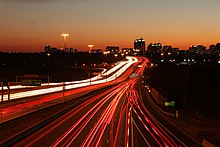 Highways are extended linear sources of pollution. Roadway noise increases with operating speed so major highways generate more noise than arterial streets. Therefore, considerable noise health effects are expected from highway systems. Noise mitigation strategies exist to reduce sound levels at nearby sensitive receptors. The idea that highway design could be influenced by acoustical engineering considerations first arose about 1973.[24][25] Air quality issues: Highways may contribute fewer emissions than arterials carrying the same vehicle volumes. This is because high, constant-speed operation creates an emissions reduction compared to vehicular flows with stops and starts. However, concentrations of air pollutants near highways may be higher due to increased traffic volumes. Therefore, the risk of exposure to elevated levels of air pollutants from a highway may be considerable, and further magnified when highways have traffic congestion. New highways can also cause habitat fragmentation, encourage urban sprawl and allow human intrusion into previously untouched areas, as well as (counterintuitively) increasing congestion, by increasing the number of intersections. 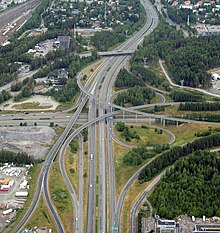 They can also reduce the use of public transport, indirectly leading to greater pollution. High-occupancy vehicle lanes are being added to some newer/reconstructed highways in the United States and other countries around the world to encourage carpooling and mass transit. These lanes help reduce the number of cars on the highway and thus reduces pollution and traffic congestion by promoting the use of carpooling in order to be able to use these lanes. However, they tend to require dedicated lanes on a highway, which makes them difficult to construct in dense urban areas where they are the most effective. To address habitat fragmentation, wildlife crossings have become increasingly popular in many countries. Wildlife crossings allow animals to safely cross human-made barriers like highways.[26] Road traffic safety[edit]Road traffic safety describes the safety performance of roads and streets, and methods used to reduce the harm (deaths, injuries, and property damage) on the highway system from traffic collisions. It includes the design, construction and regulation of the roads, the vehicles used on them and the training of drivers and other road-users. A report published by the World Health Organization in 2004 estimated that some 1.2 million people were killed and 50 million injured on the roads around the world each year[27] and was the leading cause of death among children 10–19 years of age. The report also noted that the problem was most severe in developing countries and that simple prevention measures could halve the number of deaths.[28] For reasons of clear data collection, only harm involving a road vehicle is included.[29] A person tripping with fatal consequences or dying for some unrelated reason on a public road is not included in the relevant statistics. Statistics[edit] 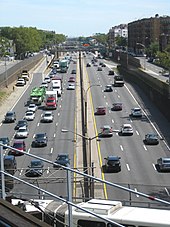 The United States has the world's largest network of highways, including both the Interstate Highway System and the United States Numbered Highway System. At least one of these networks is present in every state and they interconnect most major cities. It is also the world's most expensive mega-project,[30] as the entirety of the Interstate Highway System was estimated to cost $27 billion in 1955 (equivalent to $240 billion in 2023[31]).[32] China's highway network is the second most extensive in the world, with a total length of about 3,573,000 kilometres (2,220,000 mi).[33][34][35][36][37] China's expressway network is the longest Expressway system in the world, and it is quickly expanding, stretching some 85,000 kilometres (53,000 mi) at the end of 2011.[38][39] In 2008 alone, 6,433 kilometres (3,997 mi) expressways were added to the network.[40]
| ||||||||||||||||||||||||||||||||||||||||||||||||||||||||||||||||||||||||||||||||||||||||||||||||||||||||||||||||||||||||||||||||||||

